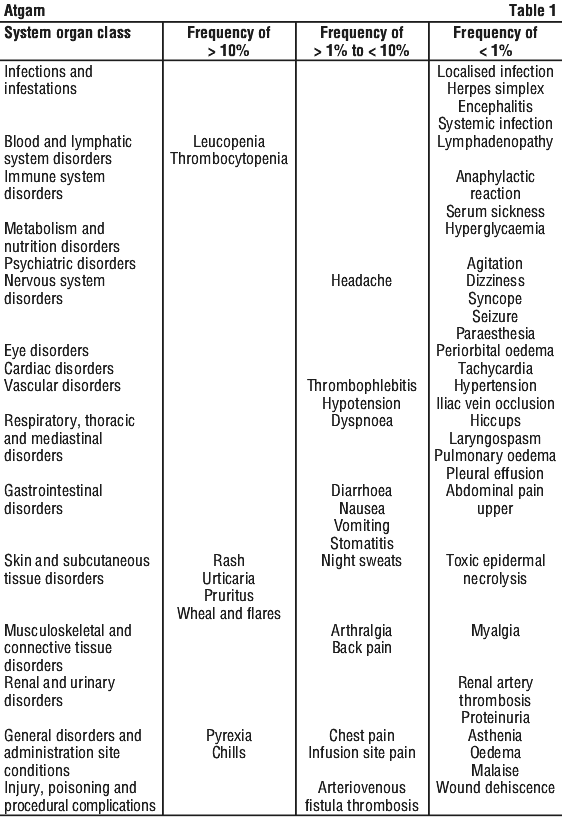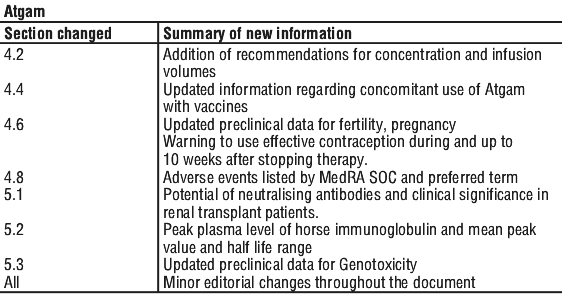SUMMARY CMI
Atgam®
Consumer Medicine Information (CMI) summary
The full CMI on the next page has more details. If you are worried about using this medicine, speak to your doctor or pharmacist.
1. Why am I being treated with Atgam?
Atgam contains the active ingredient, equine antithymocyte immunoglobulin. It is a type of horse protein used to help control your body's immune system to foreign protein. Atgam is used after a kidney transplant to stop your body's immune system from rejecting the new kidney. For more information, see Section 1. Why am I being treated with Atgam? in the full CMI.
2. What should I know before treatment with Atgam?
Do not use if you have ever had an allergic reaction to Atgam/equine antithymocyte immunoglobulin or other horse proteins (equine gamma globulins) or any of the ingredients listed at the end of the CMI.
It is possible for products developed from horse or human blood to carry infectious diseases like viral hepatitis and AIDS.
Talk to your doctor if you have any other medical conditions, take any other medicines, or if you are pregnant or plan to become pregnant or are breastfeeding. For more information, see Section 2. What should I know before treatment with Atgam? in the full CMI.
3. What if I am taking other medicines?
Some medicines may interfere with Atgam and affect how it works.
More instructions can be found in Section 3. What if I am taking other medicines? in the full CMI.
4. How is Atgam given?
Atgam will be given to you by your doctor usually after skin testing. It is diluted and given by slow infusion into a vein over a period of at least 4 hours. You will be monitored during treatment in case you have an allergic reaction to Atgam. If you have an allergic reaction, treatment with Atgam will be stopped. You may need to have regular checks for new infections.
More instructions can be found in Section 4. How is Atgam given? in the full CMI.
5. What should I know during treatment with Atgam?
| Things you should do |
|
| Driving or using machines |
|
| Looking after your medicine |
|
For more information, see Section 5. What should I know during treatment with Atgam? in the full CMI.
6. Are there any side effects?
Side effects include swollen face, lips, tongue, difficulty breathing, hives (anaphylaxis); fever, chills, sore mouth/throat, feeling unwell or tired; cold sores, eye or genital infections; cough; hiccups; throat muscle spasms; pain, swelling/redness at injection site; nosebleed; surgical wounds not healing; sweating/night sweats; stomach pain; loss of appetite; nausea; vomiting; diarrhoea; constipation; skin rash, itchiness, blisters, peeling skin; dizziness; feeling faint; confusion; hallucinations; convulsions; headache; swollen feet/leg or around eyes; swollen lymph gland; swollen tonsils; leg or joint pain; low or high blood pressure; fast or slow heart rate; purplish, bulging veins; aching muscles; tingling sensation; paralysis; abnormal movement/tremor/rigidity; chest pain when breathing; difficulty speaking, light sensitivity; lower back or side pain; coloured or blood in stools; dark or blood in urine, change to urine frequency or volume; bruising or bleeding easily; blood, liver or kidney problems showing as abnormal blood test results.
For more information, including what to do if you have any side effects, see Section 6. Are there any side effects? in the full CMI.
FULL CMI
Atgam®
Active ingredient(s): Equine antithymocyte immunoglobulin
Consumer Medicine Information (CMI)
This leaflet provides important information about treatment with Atgam. You should also speak to your doctor or pharmacist if you would like further information or if you have any concerns or questions about using Atgam.
Where to find information in this leaflet:
1. Why am I being treated with Atgam?
2. What should I know before treatment with Atgam?
3. What if I am taking other medicines?
4. How is Atgam given?
5. What should I know during treatment with Atgam?
6. Are there any side effects?
7. Product details
1. Why am I being treated with Atgam?
Atgam contains the active ingredient, equine antithymocyte immunoglobulin (a type of horse protein used to help control your body's immune system response to foreign protein).
Atgam is used after a kidney transplant to stop your body's immune system from rejecting the new kidney.
Your doctor may prescribe Atgam for another purpose.
2. What should I know before treatment with Atgam?
Warnings
Do not use Atgam if you are allergic to Atgam/equine antithymocyte immunoglobulin or other horse proteins (equine gamma globulins) or any of the ingredients listed at the end of this leaflet.
Check with your doctor if you
- have previously been treated with Atgam
- have had an allergic reaction to similar types of products.
Before being treated with Atgam, your doctor usually will do a skin test to see if you are likely to have an allergic reaction to Atgam.
It is possible for products developed from horse or human blood to carry infectious diseases like viral hepatitis and AIDS.
During treatment, you may be at risk of developing certain side effects. It is important you understand these risks and how to monitor for them. See additional information under Section 6. Are there any side effects?
Pregnancy and breastfeeding
Tell your doctor if you are pregnant or intend to become pregnant, are breastfeeding or intend to breastfeed. Your doctor will discuss the risks and benefits to you and your baby.
If you are a woman of childbearing potential, you should use effective contraception during and for at least 10 weeks after treatment.
Children
There has been limited use of Atgam in children. It has been safely used in a small number of children who have had kidney, liver or bone marrow transplants and aplastic anaemia (anaemia due to the absence of bone marrow).
3. What if I am taking other medicines?
Tell your doctor or pharmacist if you are taking any other medicines, including any medicines, vitamins or supplements that you buy without a prescription from your pharmacy, supermarket or health food shop.
Check with your doctor or pharmacist if you are not sure about what medicines, vitamins or supplements you are taking and if these affect Atgam.
4. How is Atgam given?
How much will be given
Your doctor will decide what dose of Atgam you need and when you should start treatment with Atgam.
Your doctor will usually give you other medicines when you are given Atgam. These medicines are also used to reduce your immune response to the new kidney.
If you use too much Atgam
Atgam will be given under medical supervision so an overdose is unlikely.
5. What should I know during treatment with Atgam?
Things you should do
Keep follow up appointments with your doctor or clinic.
Have any blood tests requested by your doctor.
Tell your doctor if you plan to be vaccinated or have recently been vaccinated. Having a vaccination during or soon after treatment with Atgam may reduce the effectiveness of the vaccine. Remind any doctor or dentist you visit that you are using Atgam.
Driving or using machines
Be careful before you drive or use any machines or tools until you know how Atgam affects you.
Atgam may cause dizziness, faintness, convulsion, confusion in some people
Drinking alcohol
No information available.
Looking after your medicine
Atgam is stored in a hospital which is responsible for storing and disposing of any unused product correctly.
6. Are there any side effects?
All medicines can have side effects. Most side effects are minor and temporary. However, some side effects may need medical attention.
See the information below and, if you need to, ask your doctor or pharmacist if you have any further questions about side effects.
Side effects
| Side effects | What to do |
| Speak to your doctor if you have any of these side effects and they worry you. |
| Side effects | What to do |
| Call your doctor straight away, or go straight to the Emergency Department at your nearest hospital if you notice any of these serious side effects. |
Tell your doctor or pharmacist if you notice anything else that may be making you feel unwell.
Other side effects not listed here may occur in some people.
Reporting side effects
After you have received medical advice for any side effects you experience, you can report side effects to the Therapeutic Goods Administration online at www.tga.gov.au/reporting-problems. By reporting side effects, you can help provide more information on the safety of this medicine.
Always make sure you speak to your doctor or pharmacist before you decide to stop taking any of your medicines.
7. Product details
This medicine is only available with a doctor's prescription.
What Atgam contains
| Active ingredient (main ingredient) | equine antithymocyte immunoglobulin |
| Other ingredients (inactive ingredients) | glycine, Water for Injections, sodium hydroxide and hydrochloric acid. |
Atgam does not contain any preservatives.
Do not take this medicine if you are allergic to any of these ingredients.
What Atgam looks like
Atgam is sterile, transparent to milky solution which is colourless or light brown. It may develop a slight granular or flaky deposit during storage. It is supplied in 5 mL ampoules.
Australian Registration Number: Aust R 12282.
Who distributes Atgam
Pfizer Australia Pty Ltd
Sydney NSW.
Toll Free Number: 1800 675 229.
www.pfizermedicalinformation.com.au.
This leaflet was prepared in January 2024.
®Registered trademark
Published by MIMS March 2024

 Medical events similar to those listed above have been reported in patients receiving Atgam for reasons other than prevention of renal allograft rejection.
Medical events similar to those listed above have been reported in patients receiving Atgam for reasons other than prevention of renal allograft rejection.